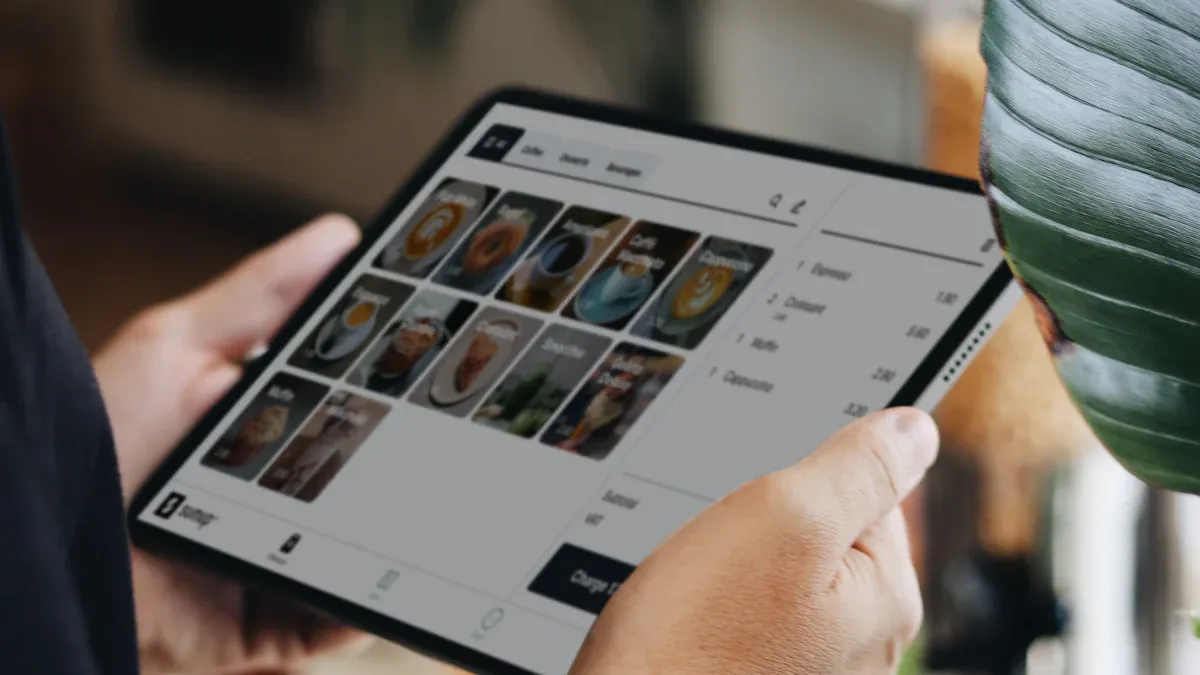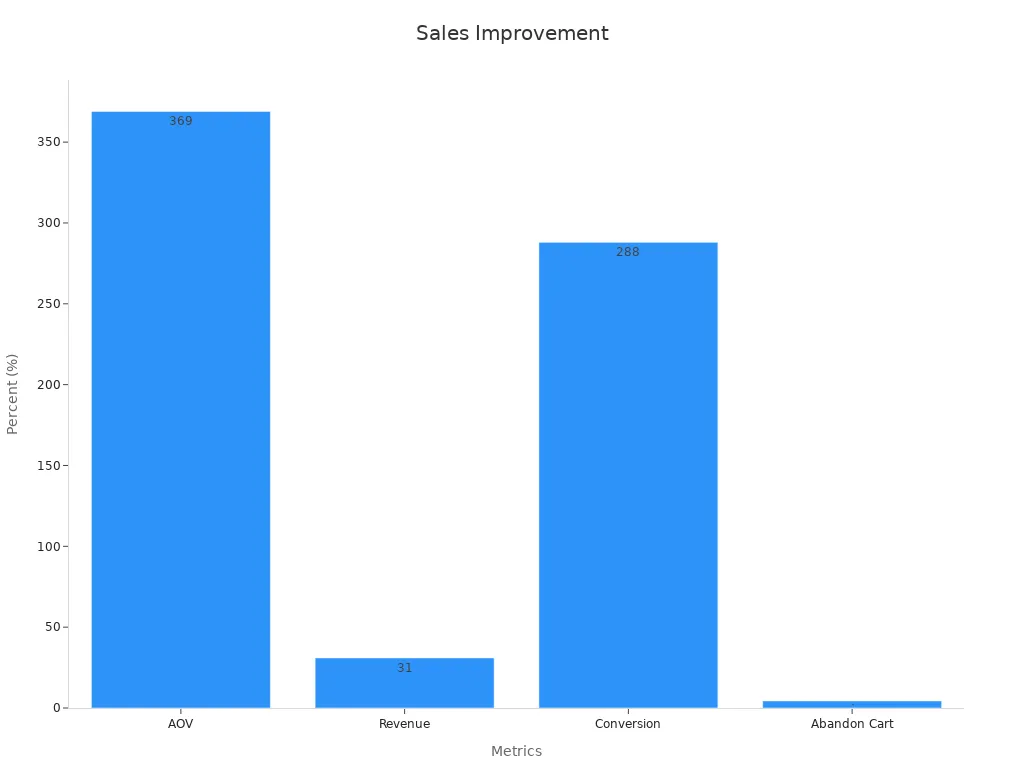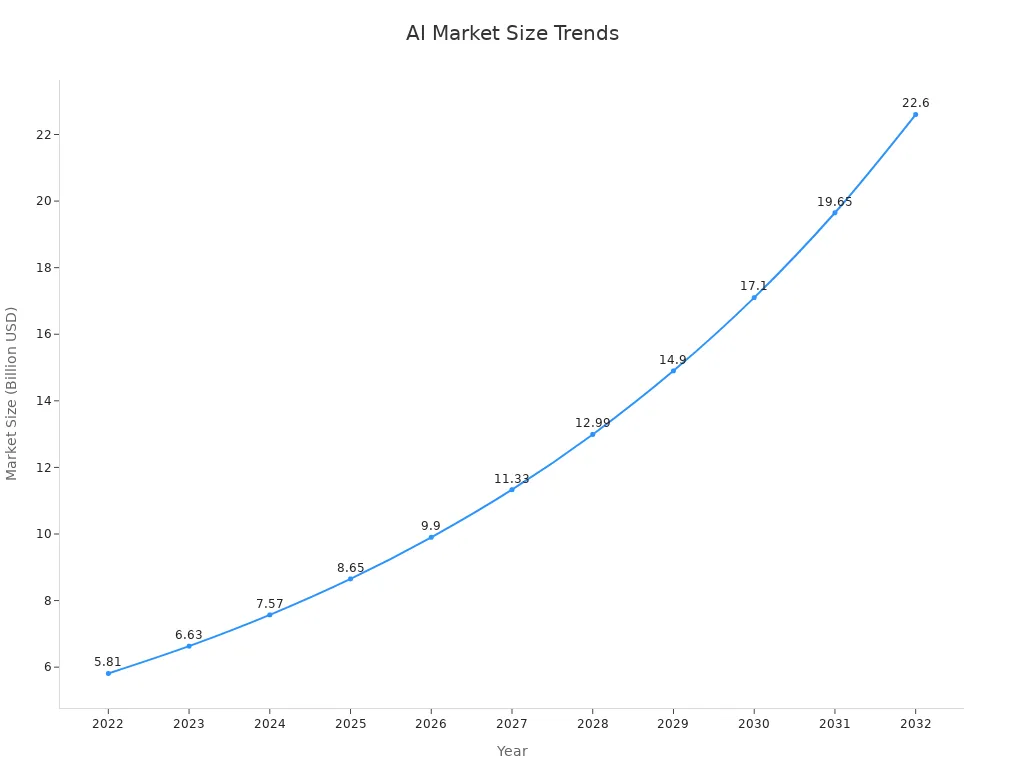AI Strategies for Boosting Holiday Sales

The holiday season is a great time for businesses to grow, and implementing AI strategies makes this even better by adding smart tools. AI helps find patterns that people might not notice, enhancing decision-making. For example, AI predictions are 33% more accurate, which reduces mistakes and keeps you ready for demand. In 2024, AI strategies contributed to creating $229 billion in online sales worldwide, showcasing their strength in driving revenue. AI can suggest products or set better prices, and these strategies help bring in more shoppers while creating amazing experiences.
Key Takeaways
AI helps holiday sales by making shopping more personal. This makes customers happier and boosts earnings.
Using AI to suggest products can grow sales by 288%. It also lowers the number of carts left behind by 4.35%.
AI helps businesses show ads to the right people. This makes sure ads appear at the best time and keeps customers interested.
AI chatbots give fast help to customers. They save time and solve problems 92% quicker, making customers happier.
Predictive tools let businesses guess what people will buy. This helps them stock the right items and avoid having too much or too little.
The Role of AI in Holiday Sales
Changing How We Shop and Sell
AI has changed shopping and selling during the holidays. It’s not just easier—it’s smarter and more personal. For example, AI suggestions affect 63% of purchases, helping you find what you want. Businesses also solve customer problems in 5.4 minutes, much faster than the old 38-hour average. This helps both shoppers and stores.
AI does more than help customers. It increases sales too. Companies using AI see a 79% rise in revenue, with 20% of it from AI strategies. Big companies like Amazon use AI, with 35% of their sales coming from AI suggestions. These facts show how AI is changing shopping and selling. Businesses need AI to stay ahead.
Metric | Value |
|---|---|
Influence of AI recommendations on purchases | 63% |
Reduction in customer query resolution time | 5.4 minutes |
Increase in business revenue from AI | 79% |
Contribution of AI recommendations to Amazon's sales | 35% |
Why AI is Important for Holiday Marketing
Holiday ads are now more personal, thanks to AI. Instead of general ads, you get ones made just for you. AI studies your data to send messages that feel personal. It also changes ads quickly to save money and improve results.
Think about getting an email with gift ideas based on your searches. Or seeing ads for items you like. That’s AI working. AI also powers chatbots that answer questions anytime. Over 90% of U.S. stores now use AI tools during the holidays. This shows how important AI has become.
AI doesn’t just make shopping better—it helps stores succeed. It targets ads better and spends money wisely. Generative AI even creates custom messages for different groups of people. This makes holiday marketing more personal and effective. AI is truly changing how holiday campaigns work.
AI Strategies for Personalization

Customizing Product Recommendations
Think about a store where every item is perfect for you. That’s what AI does for online shopping. It looks at what you’ve bought, searched for, and liked. Then, it suggests items you’ll probably want. This makes shopping quicker and more fun.
AI-powered recommendations are a big win for businesses. For example, they make up 31% of online store earnings. They also increase sales by 288% after one suggestion. Plus, they lower the number of abandoned carts by 4.35%. Here’s how these strategies help sales:
Metric | Evidence |
|---|---|
Average Order Value (AOV) | AOV grows by 369% with one recommendation, more with clicks. |
Revenue Contribution | Recommendations bring in 31% of online store earnings. |
Conversion Rates | Sales rise by 288% after one recommendation interaction. |
Shopping Cart Abandonment | Personalized suggestions cut cart abandonment by 4.35%. |

When stores use AI like this, they don’t just sell more. They make shopping feel personal and special. That’s why big online stores credit AI for 30% of their earnings.
Personalizing Email and Text Campaigns
Have you ever gotten an email or text that felt personal? That’s AI at work. It studies what you like and sends messages that match your interests. These aren’t boring emails—they’re made just for you, so you’re more likely to read them.
Personalized emails earn 31% more money per send. Super-customized campaigns do even better, with six times more sales. During Cyber Week 2023, AI-powered texts helped stores make $1.8 billion online. These numbers prove how powerful personalized messages are.
Here’s why they work:
You’re more likely to open emails that feel important to you.
Custom messages make you feel special and loyal to the brand.
Offers based on your likes make you want to buy.
AI doesn’t just help stores sell more—it helps them connect with you better.
Enhancing On-Site Shopping Experiences
Shopping online should be as easy as visiting your favorite store. AI makes this happen by improving how websites work. It creates custom pages and smart search tools to help you find what you need fast.
Some stores even use AI with augmented reality (AR). Imagine using your phone to see how a couch looks in your home. These tools make shopping fun and help you choose with confidence.
Studies show AI improves shopping in three ways:
It makes shopping more fun with cool features.
It fixes problems like finding the right size or color.
It builds trust by giving helpful and accurate suggestions.
When stores use AI to improve their websites, they’re not just upgrading their tech. They’re making shopping so good that you’ll want to come back.
Predictive Analytics for Holiday Success
Forecasting Customer Demand
Imagine knowing what shoppers want before they shop. That’s what predictive analytics does. By studying past data, you can guess which products will be popular. This helps you stock up on favorites and avoid running out. For example, time series analysis finds patterns like holiday sales spikes. Moving averages smooth out short-term changes, showing clearer future trends.
Forecasting Method | Description | Example Use Case |
|---|---|---|
Time Series Analysis | Looks at past data to find patterns like seasonal trends. | Stores predict holiday sales increases or back-to-school shopping peaks. |
Moving Averages | Uses past data averages to predict demand and reduce short-term noise. | Clothing stores plan stock by checking average monthly sales. |
Exponential Smoothing | Focuses more on recent data to predict fast-changing trends. | Tech stores forecast demand for new gadgets based on recent sales. |
These methods help you prepare for busy holiday shopping. Predictive analytics ensures you have enough stock without overbuying or underbuying.
Identifying Shopping Trends
Holiday shopping habits change fast. Predictive analytics helps spot these changes by studying customer actions. For example, it can show the rise of BOPIS (Buy Online, Pick Up In-Store) or shifts in brand loyalty. This data helps you adjust your plans to match what shoppers want.
Aspect | Details |
|---|---|
BOPIS Usage | Brands learn about BOPIS trends, pricing, and promotions to predict future habits. |
Shopper Behavior | AI studies shopper actions to find useful patterns for businesses. |
Customer Segmentation | AI improves customer grouping, personalizes shopping, and analyzes customer feelings. |
Marketing Optimization | AI helps brands improve ads, product success, and teamwork with retailers. |
By learning these trends, you can create shopping experiences that customers love. This boosts sales and builds loyalty.
Optimizing Pricing and Promotions
Pricing is key to holiday sales success. Predictive analytics uses AI to study customer data and market trends for better pricing. Dynamic pricing changes prices in real-time based on demand. This keeps you competitive and increases profits.
Pricing Model | AI Application |
|---|---|
Dynamic Pricing | Changes prices based on demand to stay competitive and profitable. |
Project-Based Pricing | Uses AI to price projects by analyzing needs and materials. |
Value-Based Pricing | Uses customer data to match products and features to their needs. |
Promotions also improve with predictive analytics. By reviewing past campaigns, you can see what worked best. This helps you create deals that attract customers and boost sales. Metrics like revenue per user and customer costs show how well your strategies work.
Pro Tip: Test pricing models and promotions with predictive analytics before launching. This ensures you offer great deals while staying profitable.

By mixing AI tools with predictive analytics, you can improve pricing and promotions to increase holiday sales.
AI-Powered Advertising Strategies
Targeting the Right Audience
Finding the right shoppers is crucial for holiday success. AI makes this easier by studying customer data like age, habits, and past buys. It spots patterns to help you focus on specific groups. For instance, it can group people based on their interest in holiday items. This lets you create ads that feel personal and connect with them.
Think about sending special ads to people who love holiday gifts or decor. AI ensures your ads reach the right people at the perfect time. Since 84% of shoppers want to feel valued, AI helps you meet their needs and boost interest.
Pro Tip: Use AI to find hidden customer likes. This makes your ads feel more personal and meaningful.
Optimizing Ad Spend
Holiday ads can cost a lot, but AI helps you save. Tools like AI Smart Bidding can cut costs by 30%. AI watches how your ads perform and adjusts spending to get better results.
For example, video ads powered by AI can boost sales by 111%. They also improve return on ad spend (ROAS) by 3.7 times compared to manual methods. These numbers show that AI not only saves money but also delivers better results.
Metric | Result |
|---|---|
Cost per Acquisition Reduction | |
Incremental Sales Increase | 111% higher with AI-powered video ads |
ROAS Improvement | 3.7 times better than manual campaigns |
Tip: Start testing AI ad strategies early to save money and increase sales.
Leveraging AI for Multichannel Campaigns
The holidays need ads on many platforms, and AI makes this simple. AI tools work across social media, email, and search engines to give customers a smooth experience. Real-time tracking helps you see how ads are doing and make quick changes.
For instance, AI can help you match promotions on Instagram, Google Ads, and emails. This keeps your message clear and your audience interested. Studies show using multiple channels boosts sales and builds loyalty during the holidays.
Evidence Type | Description |
|---|---|
AI tracks campaigns and adjusts them instantly. | |
Multichannel integration | AI connects platforms for a smooth customer experience. |
Multichannel strategy | Using many channels is key to increasing holiday sales. |
Pro Tip: Use AI to link your holiday ads across platforms. This creates a smooth experience that keeps customers returning.
Customer Service Automation with AI
Using Chatbots for Quick Help
Chatbots are like online helpers, always ready to assist. They work all day and night, answering questions and solving problems fast. They even guide shoppers while buying things. No more waiting hours for answers! Chatbots can talk to many people at once, which is super helpful during busy holidays.
For example, chatbots save teams 2 hours and 20 minutes daily by doing simple tasks. They make answering tickets easier by 84%, so workers can handle harder problems. Businesses using chatbots also cut costs by 30% and solve issues 92% faster.
Metric | What It Means |
|---|---|
Response Time | Chatbots reply super fast, often in seconds. |
Resolution Speed | They fix problems quickly, making customers happy. |
Deflection Rate | Chatbots handle lots of questions without needing human help. |
Pro Tip: Let chatbots handle easy questions. This gives your team time for bigger tasks.
Making Returns and Refunds Easier
Returns and refunds can be tricky, especially during holidays. AI makes it simple by automating steps and avoiding mistakes. It tracks return requests, speeds up refunds, and keeps customers updated.
Stores using AI for returns cut costs by 72% and grow revenue by 69%. AI tools also make refunds accurate, so customers get the right amount quickly. This saves time and builds trust with shoppers.
Statistic | Percentage |
|---|---|
Retailers reporting an increase in annual revenue | 69% |
Retailers experiencing a decrease in operating costs | 72% |
Did You Know? Shoppers are more likely to return if refunds are fast and easy.
Boosting Customer Connections
AI doesn’t just fix problems—it helps stores connect with shoppers. By studying data, AI guesses what customers need and offers smart solutions. For example, it can check emotions to reply in a kind way.
Stores using AI see a 25% rise in customer satisfaction and cut call times by 30%. Predictive tools also let stores help before customers even ask. This personal touch builds loyalty and keeps shoppers coming back.
Metric | Improvement |
|---|---|
Average Call Handling Time | Reduced by 30% |
Customer Satisfaction Scores | Increased by 25% |
Pro Tip: Use AI to send special offers or messages based on what customers like. It makes them feel important.
Inventory Management Using AI
Predicting Stock Needs
AI makes planning inventory easier. It studies past data and current trends to guess what products you’ll need. It even considers holidays, weather, and local events to predict demand. This helps you stock popular items before they sell out.
AI Application | Benefit |
|---|---|
Demand Prediction | Keeps shelves stocked without having too much or too little. |
Sales Forecasting | Makes managing inventory more accurate and faster. |
Trend Analysis | Prepares businesses for changes in holiday shopping habits. |
AI doesn’t just help you plan—it saves money too. Accurate guesses mean less waste and fewer leftover products after the holidays.
Pro Tip: Use AI tools to plan for busy times. This ensures you have what shoppers want most.
Avoiding Overstock and Stockouts
Running out of items during holidays can upset customers. Having too much stock wastes money. AI fixes both by balancing inventory levels. It uses predictions to keep just the right amount of stock.
Businesses using AI report:
22% less extra inventory sitting around
19% faster inventory turnover
AI also watches sales trends live. If something becomes popular, it adjusts orders to meet demand. This keeps customers happy and your store running smoothly.
Did You Know? AI predictions help avoid overstock by guessing inventory needs correctly. This saves money and space.
Enhancing Supply Chain Efficiency
AI improves more than inventory—it upgrades your supply chain. It speeds up delivery times, lowers storage costs, and boosts inventory turnover. These changes make your business quicker and cheaper to run.
Description | |
|---|---|
Inventory Turnover Ratio | Shows how often items are sold and replaced; higher is better. |
Stockout Rate | Tracks how often items run out; lower rates mean happier shoppers. |
Carrying Cost of Inventory | Includes storage costs; AI helps cut these expenses. |
Lead Time | Time from order to delivery; shorter times improve service. |
AI systems also suggest reorder plans based on past data. This keeps you ready for busy shopping days.
Pro Tip: Use AI to check supply chain performance. It helps find and fix problems before they cost you money.
AI-Driven Content Creation
Writing Exciting Marketing Messages
Making marketing messages that catch attention can be tough. AI helps by studying customer data to create messages people like. For example, it can make gift guides based on what shoppers enjoy and their budgets. AI also writes catchy email subject lines and custom messages for each person.
Big companies like Coca-Cola use AI for content creation. In 2023, their AI made over 120,000 pieces of content. Visitors spent more than seven minutes on their site because of this. Unilever also used AI to write faster, cutting writing time by 90%. These examples show how AI can improve holiday campaigns.
Tip: Look at past campaigns with AI to see what worked. Use those ideas to make better content.
Automating Social Media Posts
Posting on social media during holidays can be stressful. AI makes it easier by creating and scheduling posts for you. This keeps your brand active without needing constant work. Imagine having holiday posts ready with fun captions and hashtags, all done by AI.
AI also improves your social media strategy as it runs. It changes ads based on how people react to them. For example, AI can create ads that adjust to user interest, helping you reach more people. By automating these tasks, you can focus on other holiday plans.
Pro Tip: Use AI to schedule posts on different platforms. This saves time and keeps your message clear.
Making Custom Holiday Videos
Videos are a fun way to connect with customers, and AI makes them easy to create. With AI, you can make videos that feel personal. For example, show gift ideas based on what someone has searched for or bought before.
AI tools also make video creation faster and cheaper. PepsiCo used AI to run successful campaigns, proving how helpful it is. Personalized videos grab attention and make customers feel special. This builds loyalty and increases sales.
Did You Know? Personalized videos can boost engagement by up to 80%. That’s a big chance to stand out during the holidays.
AI tools have changed holiday sales, making them better and faster. Businesses using AI see great results, like higher sales and happier customers. For example, AI helped with $199 billion in holiday orders, which is 17% of all orders. About 60% of business owners think AI will grow sales, and 64% say it improves customer relationships.
Statistic Description | Value |
|---|---|
Total holiday shopping orders influenced by AI | $199 billion |
Percentage of all holiday orders influenced by AI | 17% |
Business owners predicting AI will drive sales growth | 60% |
Business owners believing AI will improve customer relations | 64% |
Growth in customer satisfaction after AI implementation | 30% |
Using AI isn’t just about keeping up—it’s about doing better. AI helps with things like personalizing shopping and managing stock. Want to improve your holiday sales? Try AI tools or ask experts to help you use them well.
FAQ
What is the main advantage of using AI for holiday sales?
AI saves time and increases sales. It makes shopping personal, predicts trends, and manages stock well. You can focus on growing your store while AI handles tough tasks. It also gives customers special suggestions and faster help, making them feel important.
Are AI tools affordable for small businesses?
Yes! Many AI tools are low-cost and made for small stores. Tools like ChatGPT or Shopify’s AI features are budget-friendly. Start with simple tools for emails or product suggestions. You’ll see good results without spending too much.
How does AI make customers happier?
AI makes shopping quick and easy. Chatbots answer questions fast, and custom emails or suggestions make shoppers feel special. It also keeps popular items in stock with smart predictions. These features create a smooth experience, keeping customers happy and loyal.
Do I need tech skills to use AI?
No! Most AI tools are simple to use and need no coding. Platforms like HubSpot or Google Ads have easy-to-use AI features. Tutorials and support teams can help you start quickly.
How does AI help with holiday ads?
AI makes custom ads, emails, and social posts. It studies customer data to find the right audience and updates campaigns fast. This saves money and reaches more people. AI also tracks results, so you can improve your plans easily.
See Also
Proven Blogging Techniques to Enhance Startup Growth and Brand Awareness
Key Approaches to Enhance Blog Performance for SEO Excellence
Five Essential Tactics to Elevate Healthcare Content Marketing
Comprehensive Techniques for Off-Page SEO Success Explained
Boosting Blog Traffic Through Effective Email Engagement Techniques

